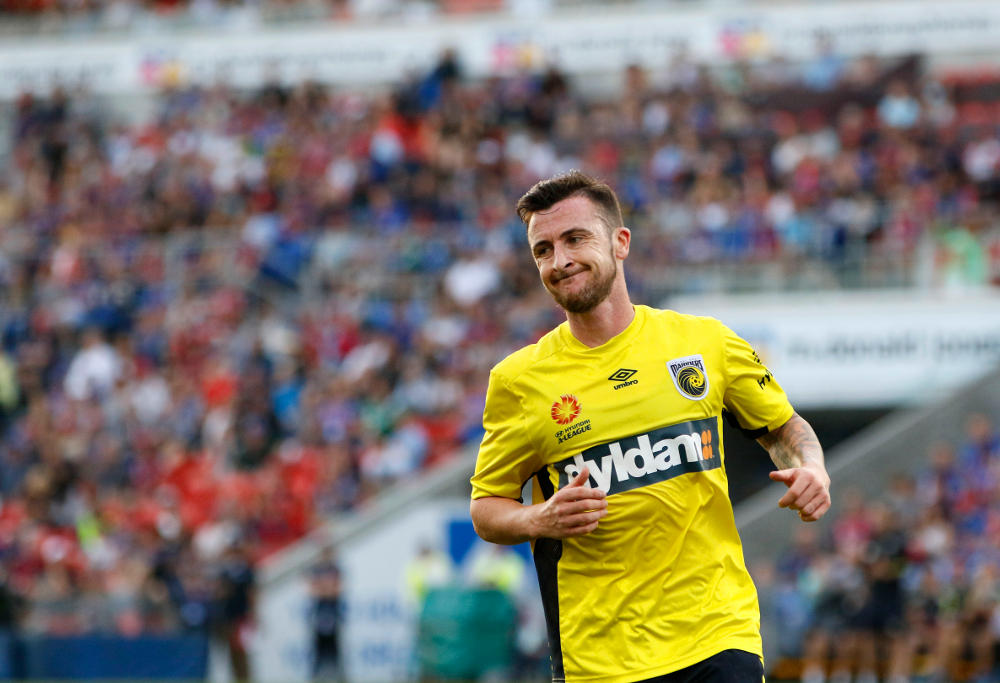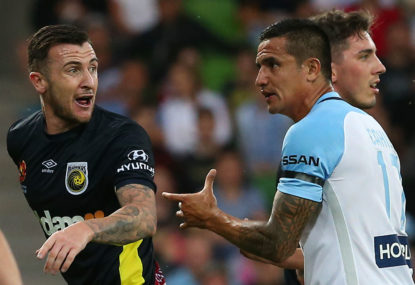With the match poised at 1-1, the A-League’s bottom team were jutting out their jaws, snorting in defiance of a conclusion that had, not long earlier, seemed inevitable.
Melbourne City, their opponents, had scored after three minutes; an early pasting was in order, with Tim Cahill already having boxed the corner flag – a tearful Central Coast ball-boy weeping in Gosford, unable to prevent the violence – and City licking their lips in anticipation of the emphatic win that might reinvigorate their season.
But the Mariners had rallied and, inevitably, found fortune in City’s lardy centre.
One Connor Pain venture up the left wing needed a simple pull-back, to the penalty spot, to find Roy O’Donovan utterly unmarked and free to slot home with ease.
A lax moment – typical of City this season, but no less galling to see – and the Mariners had thrown off the shackles of fate. No pasting here, not yet at least.
Then, as a lofted ball was chipped up towards their goalscorer, O’Donovan raised his arm, feeling for Michael Jakobsen’s presence, and made contact with the City defender’s face. Enraged, but clearly not hurt in the slightest, Jakobsen sprung up off the turf, squaring with the Irish Mariner, eye-to-eye, incensed and indignant.
As O’Donovan shrugged sheepishly and Jakobsen smouldered, Dean Bouzanis sprinted 30 full metres to offer his wholly irrelevant opinion to the match officials, both referee and linesman, who were already deep in discussion.
O’Donovan was sent off.

The match had been flickering attractively into life – perhaps another AAMI Park classic like City’s 3-3 against Perth earlier this season. There was a clear clash of classes here; the flushed Citizens, with their spangling marquees, clad in resplendent white and blue, against the basement dwellers, scrounging and sweating, trying to save another manager from the axe.
The dismissal tore down all of this, and when Tim Cahill scored his second goal, 15 minutes later, the fate the Mariners had done so well to scrub away grew back thicker and hairier.
The contact, as illustrated by Jakobsen’s vim and vigour immediately following, was inconsequential. O’Donovan had had a sneaky glance backward – an incriminating one, in all honesty – before he raised his arm, implying that the height of his limb and the direction it swung in may have been completely intentional.
Had he really wanted to hurt the Dane? He could have manoeuvred his elbow in a much more lethal way, if he had cared to, or waited for some other moment to plant his studs on Jakobsen’s Achilles or shin.
We slip now into arguments over intent, messy areas of football officiating that have no clear answer, no matter how long the discussion stretches on.
What was clear was that the arm-to-head contact, intentional or not, was not serious, and did not hurt anyone more than any other pedestrian skirmish. But the punishment for it ruined the viability of the contest, and obliterated the precious gossamer scraps of hope the team from the Central Coast had been clutching to.
This event joins an irritatingly large collection of arm-to-head incidents this season, with the league and its officials apparently intent on filling the headline quota in eager, meaty fistfuls.
From memory, Jade North, Neil Kilkenny, Besart Berisha, and now O’Donovan have all been tangled up in moments like this, falling on either side of the punishment line, all of the cases unwelcome distractions to the main event.
It would be helpful to revisit the exact wording of the rule in question, one that has been recently changed:
“A player who, when not challenging for the ball, deliberately strikes an opponent or any other person on the head or face with the hand or arm, is guilty of violent conduct unless the force used was negligible.”
To apply this to O’Donovan’s action; the Irishman was jockeying with Jakobsen in anticipation of the arrival of the ball, which should reasonably be included in the definition “challenging for the ball”. This was not like the North-Bruno Fornaroli incident, which was away the from the play entirely. Even Berisha’s red card in the match against the Roar – which has since been overturned – occurred further away from the ball than last night’s incident.
Clearly, the word “deliberately” is problematic in the extreme, just as it is with regards to handball decisions.
And then the caveat, that excuses “negligible” force, can’t just be ignored, although it isn’t unpacked easily either. Must blood be drawn by the contact? Must treatment be sought? It was the meat of O’Donovan’s forearm that made the most contact, the least bony area, the part least likely to maim or wound.
Must there be visible evidence of an abrasion, or a bruise? Perhaps the officials must soak up the tears from the victim’s eyes and determine the weight of the liquid sorrow on a minuscule set of scales.
Or maybe the referee and his assistants would be better served assessing the practical realities of the situation, weighing up simply the apparent damage done and their impression of the egregiousness of the act, and decide based on that. Because it seems – not just in this case, but in others too – had they done that, O’Donovan would have been booked and told to get on with it.
The part of the rule that mentions a player “striking an opponent or any other person on the head or face with the hand or arm”, is drowning out the rest of the sentence.
Is it too much to ask for a little discretion? A forearm colliding innocuously with an opponent’s face isn’t an exhibition of some deadly martial art, nor is it any more violent than a tackle from behind, or a tactical shirt tug, or any other bookable offence. At least two more moments occurred later in the match last night, both actually involving Jakobsen, where arm-to-face contact was repeated, yet not even a yellow card was awarded.
O’Donovan shouldn’t have waved his arm in the way he did. But only die-hard City supporters would argue the game was better off without him, or that they’d rather see a game stage 11 versus ten.
Central Coast, in all likelihood, would have lost that game even with their full complement on the pitch. Their goal had come against the run of play, and City had been dominant up until their concession.
But what had been, for 14 sweet minutes, a potentially tasty confrontation was turned by one crimson flourish into a mauling, a lion toying with a wounded gazelle.
Central Coast struggled admirably, gritting their teeth and bucking their heads in the face of doom, but their wound was mortal.






























































































